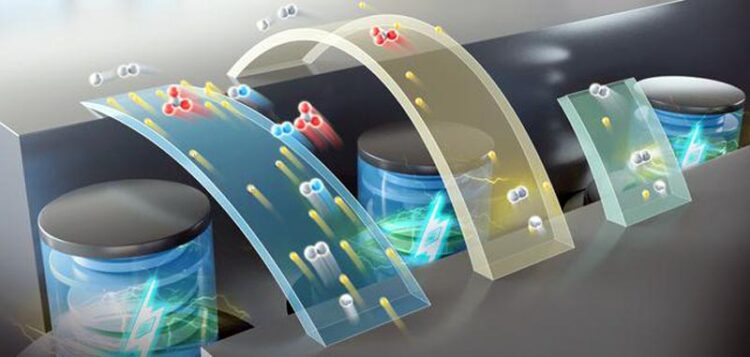High-energy-density aqueous battery based on halogen multi-electron transfer

Multi-electron transfer cathode based on bromo and iodine
Credit: DICP
Traditional non-aqueous lithium-ion batteries have a high energy density, but their safety is compromised due to the flammable organic electrolytes they utilize.
Aqueous batteries use water as the solvent for electrolytes, significantly enhancing the safety of the batteries. However, due to the limited solubility of the electrolyte and low battery voltage, aqueous batteries typically have a lower energy density. This means that the amount of electricity stored per unit volume of aqueous battery is relatively low.
In a new study published in Nature Energy, a research group led by Prof. LI Xianfeng from the Dalian Institute of Chemical Physics (DICP) of the Chinese Academy of Sciences (CAS), in collaboration with Prof. FU Qiang’s group also from DICP, developed a multi-electron transfer cathode based on bromine and iodine, realizing a specific capacity of more than 840 Ah/L, and achieving an energy density of up to 1200 Wh/L based on catholyte in full battery testing.
To improve the energy density of aqueous batteries, researchers used a mixed halogen solution of iodide ions (I–) and bromide ions (Br–) as the electrolyte. They developed a multi-electron transfer reaction, transferring I– to iodine element (I2) and then to iodate (IO3–). During the charging process, I– were oxidized to IO3– on the positive side, and the generated H+ were conducted to the negative side in the form of supporting electrolyte. During the discharge process, H+ were conducted from the positive side, and IO3– were reduced to I–.
The developed multi-electron transfer cathode had a specific capacity of 840 Ah/L. Combining the cathode with metallic Cd to form a full battery, researchers achieved an energy density up to 1200 Wh/L based on the developed catholyte.
Besides, researchers confirmed that Br– added to the electrolyte could generate polar iodine bromide (IBr) during the charging process, which facilitated the reaction with H2O to form IO3–. During the discharge, IO3– could oxidize Br– to Br2 and participated in the electrochemical reaction to realize reversible and rapid discharge of IO3–. Therefore, the bromide intermediate formed during the charge and discharge process optimized the reaction process, effectively improving the kinetic and reversibility of the electrochemical reaction.
Prof. FU’s group proved the multi-electron transfer process through in-situ optical microscopy, Raman spectroscopy and so on.
“This study provides a new idea for the design of high-energy-density aqueous batteries, and may expand the aqueous batteries application in power batteries field,” said Prof. LI.
Journal: Nature Energy
DOI: 10.1038/s41560-024-01515-9
Method of Research: Commentary/editorial
Subject of Research: Not applicable
Article Title: Reversible multielectron transfer I−/IO3− cathode enabled by a hetero-halogen electrolyte for high-energy-density aqueous batteries
Article Publication Date: 23-Apr-2024
Media Contact
Jean Wang
Dalian Institute of Chemical Physics, Chinese Academy Sciences
wangyj@dicp.ac.cn
Office: 41182464221
All latest news from the category: Life Sciences and Chemistry
Articles and reports from the Life Sciences and chemistry area deal with applied and basic research into modern biology, chemistry and human medicine.
Valuable information can be found on a range of life sciences fields including bacteriology, biochemistry, bionics, bioinformatics, biophysics, biotechnology, genetics, geobotany, human biology, marine biology, microbiology, molecular biology, cellular biology, zoology, bioinorganic chemistry, microchemistry and environmental chemistry.
Newest articles

NASA: Mystery of life’s handedness deepens
The mystery of why life uses molecules with specific orientations has deepened with a NASA-funded discovery that RNA — a key molecule thought to have potentially held the instructions for…

What are the effects of historic lithium mining on water quality?
Study reveals low levels of common contaminants but high levels of other elements in waters associated with an abandoned lithium mine. Lithium ore and mining waste from a historic lithium…

Quantum-inspired design boosts efficiency of heat-to-electricity conversion
Rice engineers take unconventional route to improving thermophotovoltaic systems. Researchers at Rice University have found a new way to improve a key element of thermophotovoltaic (TPV) systems, which convert heat…



